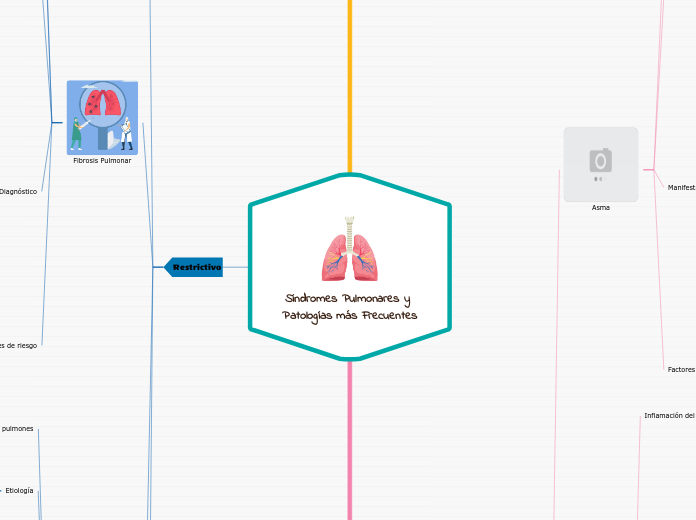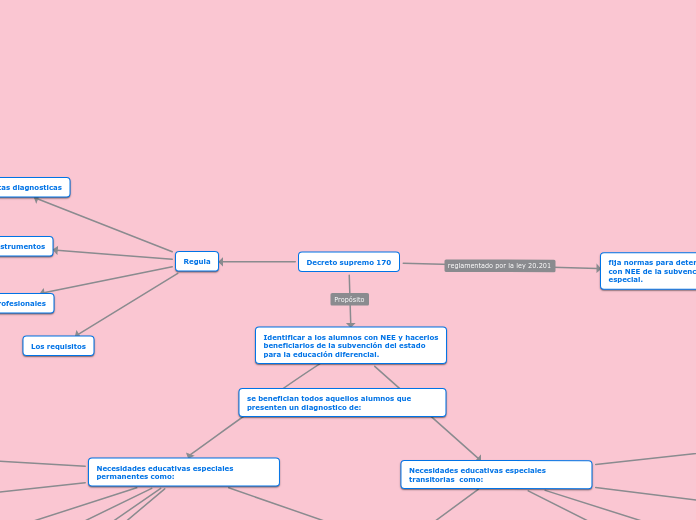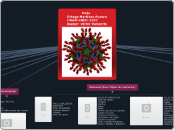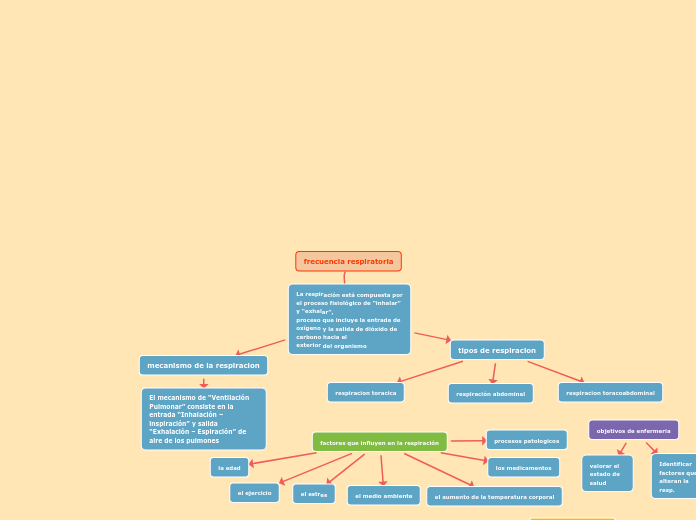Síndromes Pulmonares y Patologías más Frecuentes
To name your story, you have to think about the overall message and what you want your audience to understand from the story. Also, make it relevant and easy to remember.
Restrictivo
The ending of a story is essential. We all know that if the ending is weak, what happened before loses its importance. So make it unpredictable, but fair. A resolved ending answers all the questions and ties up any loose threads from the plot.
SDRA
Cualquier alteración
que cause daño pulmonar
Pulsioximetría
Cianosis
Repsiracion agitada
Traumatismo
Aspiración
Inhalación de químicos
Acumulación de líquido en los sacos de aire de los pulmones
No permite que el O² llegue a los órganos
Edema Pulmonar
Apnea del sueño
Diabetes
Arritmias
Electrocardiograma
Análisis de sangre
TAC
Tos
Esputo espumoso
Sensación se asfixia y ahogamiento
Traumatismo en pared torácica
Enfermedad cardiovascular
Exceso de líquido en los pulmones
Fibrosis Pulmonar
This is the closure section of the story.
See examples of possible outcomes below:
- all problems have been solved
- it's clear how each one of your characters ends up
- your main character is transformed by the challenge
Enfermedad por
Reflujo gastro-esofágico
Hipertensión pulmonar
Complicado
HRCT
Biopsia pulmonar quirúrgica
Descarte de
Otras enfermedades
Try answering these questions in order for you to come up with a closure:
- Have all problems been solved?
- Is it clear what happens with all your characters in the story?
- Has the challenged transformed your main character?
- How do the characters feel in the end?
Deterioro de la FVC
Crepitantes
Acropaquia
Tos seca
AF. Moderada
Etiologia
Desconocida
Pero avanza con el tiempo
Formación de tejido cicatricial en los pulmones
Try answering these questions to come up with a closure:
- Have all the problems been solved?
- Is there a clear picture of what happens with each character in the story?
- Has the challenge transformed your main character?
- How do the characters feel in the end?
Derrame Pleural
This is the moment when the main character surpasses the last obstacle and finally faces their greatest challenge.
The climax usually follows one of these patterns:
- realization
- resolution
- choice
Type in your answer.
Alcoholismo
Presión arterial alta
Radiología
Ecografía
TAC torácico
Examen físico
Auscultación
Percusión
Palpación
Inspección
Hemoptisis
Dolor torácico
y fiebre
Tos con o sin
Expectoración
Infecciones
Tuberculosis
Neumonia
Enfermedades digestivas
Perforaciones del tubo digestivo
Pancreatitis aguda
Enfermedades sistémicas
Artritis reumatoide
Derrame pleural
Lupus
Hipoproteinias
Nefrosis
Desnutrición
Insuficiencia
Cardíaca
Acumulación anormal de líquido en el espacio pleural
Obstructivo
The middle of the story is where you add layers of complications that will lead to the end. Reveal more about the character's journey. Did their personality go through changes? How did they overcome the challenges? And as you build up the story’s central conflict, make it more personal to that character. Also, from the middle act, you have to lead into the final act.
EPOC
Your character(s) need(s) motivation in order to solve the challenge(s).
Contaminación
Exposición a gases
Y sustancias químicas
Fumador pasivo
Secondary characters also might have motivs beacuse of which they may cross path with main character or which might trigger them to help the main character.
lo que lleva a
Opresión en el pecho
Incluso en actividad leve
Tos y exceso de esputo
Secondary characters might also have motives that lead them to cross paths with the main character or which might trigger them to help the main character.
Enfisema pulmonar
Bronquitis crónica
Enfermedad pulmonar obstrucción crónica
Why does your character need to confront this challenge? What does he/she expect to accomplish by solving it?
See a few examples:
- will marry in 3 days
- can fix the mistakes of the past
Bronquitis
Examen de esputo
Crónica
Mucosa que recubre
los bronquios
Constantemente inflamada e irritada
Tabaquismo
Infecciones
Respiratorias
repetidas
Fatiga y falta
De aliento
Tos prolongada con
mucosidad (esputo)
Aguda
Virus transmitidos a través
de las partículas de saliva
Al estornudar o toser de
una persona enferma
Resfríos e influenza
Dolor de
Cuerpo
Tos y/o
fiebre
Molestia
en el pecho
Fatiga
Sibilancias
Inflamación del revestimiento de los bronquios
Asma
Each story has a main character and that character usually needs to solve a problem or challenge. The character's challenge is the one that creates tension throughout the story.
Alérgenos
Polen
Hongos
Contaminantes ambientales
Ácaros de polvo
Pelo de animales
Prueba de función pulmonar
Espirometría
Evaluación clínica
Opresión torácica
Sibilancia
Crisis recurrente de tos
Type in any other challenges which other characters in the story need to face.
Multifactorial
Geneticos
Interacción entre genes de susceptibilidad
Medioambientales
Enfermedad inflamatoria crónica de las vías aéreas
In most stories, there are 3 challenges. The number 3 is a mystical number symbolizing completeness. Try to come up with interesting challenges with which your character needs to struggle.
See a few examples below:
- turns into a werewolf at night
- is sent back in time
Consolidativo
In the beginning of the story (or the exposition), you will need to introduce the setting and characters. You might also want to introduce the main conflict. This part of the story is important because it gives the reader necessary background information and maybe even a first insight into a character’s personality.
Atelectasia
The setting (time & place) of a story can change throughout the plot.
Sensory details include sight, sound, touch, smell, and taste. These details are important because they create depth in your setting.
See a few examples below:
- the smell of fresh bread
- the scent of freshly cut grass
- rain falling onto the windshield etc.
Enfermedad pulmonar
Objeto extraño en la vía respiratoria
Cirugía mayor reciente
Anestesia
The weather is an important element in your story because it can highly influence the ambiance and the mood of the characters.
Opacificación y pérdida
Del volumen pulmonar
Radiografía de tórax
The most affected character is the main character. Write down here if he/she is affected by these weather conditions in any way. For example, if they lost a family member or their home during a hurricane, etc.
Tos y dolor
pleurítico
Insuficiente
respiratoria
Decide if you want to include an element of nature in your story. For example, a rainbow can be a very nice choice for a happy ending. The mist in a story can represent mystery and secrets. A thunder can appear in the background at the moment when the 'bad guy' of the story makes its appearance, etc.
Disnea
Does your story include catastrophic weather? See a few suggestions below or add your own:
- hurricane, earthquake, storm, etc
The time of the story can also change. It can describe the event of a single day or can include an entire year's plot. Anyway, don't forget to mention it.
vía aérea
Compresión
Reabsorción
Contracción
Obstrucción bronquial
Your story can take place wherever your imagination will take you to.
For example: in an elevator, in an enchanted forest, etc. Don't forget to give details of the environment each time the setting changes, otherwise, the story can be confusing. Also, mention the seasons as each of them has unique weather and events.
Colapso pulmonar total
Colapso pulmonar parcial
Neumonía
Characters are essential to a good story. Usually, the protagonist(s) is/are the most affected by the plot. Introduce a character by focusing on their actions, interests, and occupation, as the physical appearance doesn't make a difference in most cases.
Factores de riesgo
Medio en el que se encuentre
Estado inmunitario-nutricional
Interacción entre enfermedades de base
Manifestaciones
Lo que lleva a
Diagnóstico
Sindrómico
Leucocitos y datos microbiológicos
Infiltrado pulmonar
Basado en cuadro clínico
Escalofríos
Dolor pleurítico
Tos y fiebre
Taquipnea
Etiología
Inhalación de MO
What is your character's main goal?
fight Evilfind lovedefeat his/her enemyrule the worldmake friendstime travelmake an awesome discoveryOther
Bacterias
Which traits best describe the character's personality? Choose more if necessary:
introvertedloyalkindindependentquick-thinkingadventuresomeidealisticsweet-naturedcalmrisk-takercreativewittystrictfussyweirdclumsyharshaggressivecarelessclingingcowardlycrueldeceitfulimpulsiveOther
Virus
Respuesta a
Microorganismos
Choose the type of your chacter:
Protagonist (main character)Antagonist (main character's opponent)Flat (stereotypical character)Round (his/ her personality develops throughout the story)Static (doesn't evolve as a person throughout the story)Dynamic (dramatical change in personality)Confidant (the main character trusts him/ her)Foil (contrasting character who enhances the personality of another character)Other
Parénquima pulmonar
A la vía aérea distal
Lesión inflamatoria pulmonar
Type in the name of your character.










